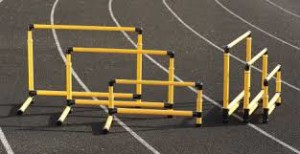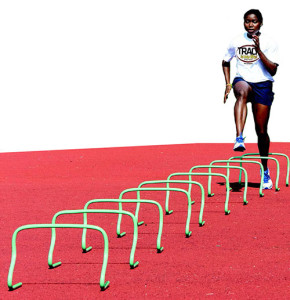Training Hurdles: When to Use Them and How
An increasingly common purchase among hurdle coaches, hurdlers, hurdle moms, and hurdle dads is that of training hurdles. Get about five of them, throw them in the trunk, and have them available whenever you need them. In this article, I will discuss the kinds of training hurdles that are currently on the market, and the various purposes they may serve to the coach and to the athlete.
[am4show not_have=’g5;’]
[/am4show][am4guest]
[/am4guest][am4show have=’g5;’]
Basically, all training hurdles fall under either one of two categories: power hurdles, and smart hurdles. Let’s take a look at both and discuss the pros and cons of each.
Power hurdles consists of a bottom part that serves as the base, and a crossbar with holes at each height. The top of the bottom part goes into the holes of the crossbar. Depending on what company you get them from, the crossbars of power hurdles are either wooden or aluminum.
Power Hurdle Pros:
What I like best about the power hurdles is that they can be adjusted in height from 21 inches to 42 inches. So they can be serviceable for the youngest beginner and the most advanced veteran.
Power hurdles are less expensive than smart hurdles. On the www.everythingtrackandfield.com website, power hurdles are listed at $39.95 per hurdle, though I’ve known people who’ve purchased them for cheaper.
Power Hurdle Cons:
My biggest complaint with power hurdles is that they blow over and fall down too easily. On a windy day, you can forget about using these things. On a breezy day, you can use them effectively if you put something heavy at the base of each side of the bottom part.
I have found that it’s difficult to adjust the height on power hurdles. Trying to fit the little knob into the hole without the knob on the other side sliding out can prove to be problematic.
Because power hurdles consist of a bottom part and a crossbar, they can be more of a hassle to transport. If I have five power hurdles with me, I will need the help of at least one of my athletes to carry all the bottoms and crossbars from the car to the track. I know of another athlete who trains by himself a lot who has a little cart that he keeps in the backseat of his car. He’ll load the bottoms and the crossbars onto the cart and wheel the cart to the track. Seems like a bit much to me, to have to go to so much trouble.
Perhaps the worst thing about power hurdles is that the crossbars break too easily. I have five of them that I bought a few months ago, and two of them have been broken already. These crossbars are wooden, and the reason I got the wooden ones is because two aluminum ones that I had borrowed from my school had been broken in half. And the athletes who broke them did not David Oliver physiques. One was a 5-6 girl. Sometimes when one of my more wreckless inexperienced hurdlers is doing reps over these hurdles, my only thought is, please don’t break one of these things in half.
***
Smart Hurdles consist of one piece, with a bottom bar on one side that rests on the ground, keeping the hurdle balanced. The hurdle height is adjustable in the same manner as a regular hurdle.
Smart Hurdle Pros:
Basically, if you look at the power hurdle cons above, you’ll see the smart hurdle pros in reverse. Let’s take a look, in the same order:
Because smart hurdles are balanced on the bottom bar, they don’t fall over.
It is very easy to adjust the height of smart hurdles. Just grab the top part on both sides and lift up or push down.
Smart hurdles are very easy to transport. Just scoop them up and go.
Smart hurdles don’t break easily. My friend bought a set of three for his son, who is an 80-meter hurdler, and all three are still in excellent condition although they’ve been hit many times.
Smart Hurdle Cons:
Smart hurdles are more expensive than power hurdles. The ones that actual hurdlers would use (as opposed to athletes in other sports and other events using them for plyometric purposes) are listed at $74.95 at www.everythingtrackandfield.com, a good $25.00 more per hurdle than the list price of the power hurdles. I would argue, however, that the smart hurdles are worth the extra cost. If you pay $40 for power hurdles but they keep breaking and you have to keep replacing them, you end up paying more in the long run anyway. Sure, you can tape a broken hurdle, but more often than not the tape gets in the way of the hole(s) that you need to put the bottom part into.
Another minor con of the smart hurdle is that they come in different sizes. The ones hurdlers would use start at 27 inches, whereas the power hurdles start at 21. I call this a minor issue because hurdlers, even beginners, rarely need to hurdle at a height lower than 27 inches. But if you buy the cheaper smart hurdles, they only go up to 36 inches. If you’re a female hurdler, or if you are a coach who knows you’ll only be coaching females, then you can save a little money by getting those instead.
It’s also worth noting that smart hurdles are made out of pvc pipe. If you are mechanically inclined (which I, unfortunately, am not), you might be able to figure out how to make smart hurdles yourself, and just purchase the materials, saving money that way.
When To use Training Hurdles:
There are four basic scenarios in which training hurdles are valuable
1) When introducing kids under the age of 11 to the hurdles. In youth track, kids aren’t allowed to start hurdling until the age of 11, but my experience has been that many are eager to start trying before then. Back in the day, that would mean having a little 4th-grader trying to clear a 30-inch standard hurdle. Training hurdles allow for a safe way to introduce little ones to hurdling before they’re ready to graduate to the standard hurdles. If you have a very young youngster, you might want to try banana steps (shown below), as it’s never too early to start hurdling!
2) When teaching beginning hurdlers. I’m not a big fan of starting off beginners with a soft approach, but I see the logic of it. The possibility of a crash and burn is very real in the hurdles, so starting off beginners with training hurdles gives them some freedom to go at the hurdles aggressively without fear of consequences. In this sense, the training hurdles serve the same purpose as training wheels on a bicycle. They get the newbie started, but once the newbie has outgrown them, it’s time to move on to the big-kid hurdles.
3) At a track meet. More and more often I’m seeing training hurdles in the warm-up areas during meets. This is because the staffs running the meets like to have the race hurdles available and ready to go as soon as the race starts, so they don’t like the hurdles moving them all over the place. In such cases, having your own set of training hurdles can prove to be invaluable. You can still do all your warm-up drills, and, best of all, because you own the hurdles, you don’t have to share them with anyone else!
4) As a last resort. Let’s say you want to train at a track that has put all its hurdles in the shed. You go there thinking there’ll be plenty of hurdles available, but when you arrive, there’s not a hurdle in sight. (Yes, I’m speaking from experience). No problem! Just pop open the trunk and pull out the training hurdles. Let’s say you want to have your athletes do some drills on the grass, at a local park, same thing applies. It’s always nice to know that if things go awry, you have a back-up plan. Training hurdles are always a viable back-up plan. If you have training hurdles in the trunk, you can practice hurdles anywhere.
Here is the direct link to everythingtrackandfield’s training hurdles page. If you’re interested in buying training hurdles, this would be the best place to start. Then you can look around the web and comparative shop from there.
[/am4show]



